Last Updated On: July 1st, 2024
The ERBs have been a staple name in education for some time now. The Educational Records Bureau is actually the company that administers the comprehensive assessments and the ERB is a nickname for the tests they provide. The assessments themselves are given by participating (typically independent or private) schools and they test on many types of knowledge. The ERBs also focus on social emotional learning and offer metrics on academics, social development, and emotional maturity.
The ERB offers four tests: CTP, Milestone Assessments, WrAP, and the ISEE. The most popular test is the ISEE by far, as it’s used as a metric for independent school admissions, offered to 2nd-12th grade students. The second most popular test, usually referred to as the ERB, is the CTP, offered to students in grades 1-11.
The CTP is similar to the Milestone Assessment and the WrAP test in that it assesses students in their academic environment and evaluates their social, emotional maturity along with math and english skills. The ISEE is quite different, in that it is used as an admissions test and I helpful in determining a student’s skills they intend to bring to their new school. It does not have any social, emotional testing within it and it should not be used to evaluate anything other than academic rigor.
CTP5
The CTP5 is a newly cultivated version of the CTP4, and was created in 2018. Each CTP5 test is slightly different per grade level, so it makes sense that the ERB hasn’t released specific timing for these tests. However, based on the sections, content, and testing site schedules, it’s safe to assume testing will approach anywhere from 3 to 4 hours. It’s without question that more advanced grade levels will have longer sections and testing will require more stamina.
The good news … you don’t have to prep! The CTP5 is just a tool used to compare student progress. It helps schools assess growth, see which classes to place your child in, compare grade levels within the school, and even gauge the differences between students across counties and states. While it can feel very daunting for a student AND a parent, it shouldn’t be something students fear or stress about.
When to Take the CTP5 …
Often schools will determine the testing season for the CTP5. However, if you’re participating in homeschooling or distance learning, there is more flexibility in the testing season of your choice. The ERB testing seasons for 2021-2023 are as follows:

It’s crucial to note, according to the ERB: “During black-out dates, no testing may take place and the Comprehensives Portal will be down for scheduled maintenance. While the Portal is down, CTP users are unable to access any of the Portal’s features including generating score reports or downloading resources from the Help and Resources section. ERB 360 Access, however, will remain available for data exploration.”
Types of Questions:
English:
The English and Language Arts section of the CPT (Comprehensive Testing Program) offers three types of questions for students.
1. Depth of Knowledge Level 1 questions are also called DOK 1 questions. These are more elementary questions that require memorization and regurgitation of material. Often they will call back to text or phrases.
Example:
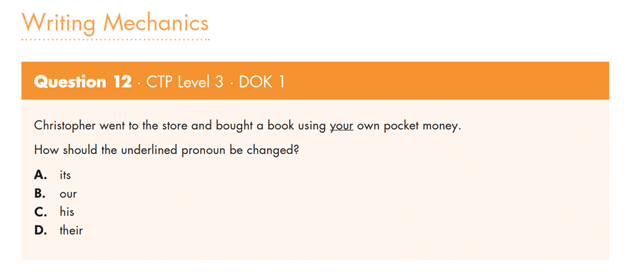
2. Depth of Knowledge Level 2 or DOK 2 questions are more complex and require the student to not only comprehend, but also to apply. Questions at this level may include words such as “summarize,” “interpret,” “infer,” “classify,” “organize,” “collect,” “display,” “compare,” and “determine whether fact or opinion.” While DOK 2 questions are more advanced than DOK 1 questions, they are often considered the intermediate skill level.
Example:
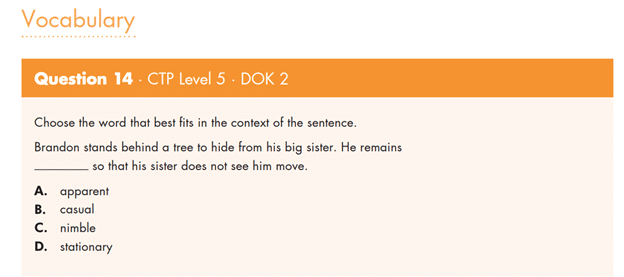
3. Depth of Knowledge Level 3 questions are also called DOK 3 questions and are naturally considered the most advanced type of question in the english section. They require inferring, theme identification, relating outside knowledge, and critical reasoning skills. These questions force students to analyze the comprehensive ideas about the texts and make educated connections between information.
Example:
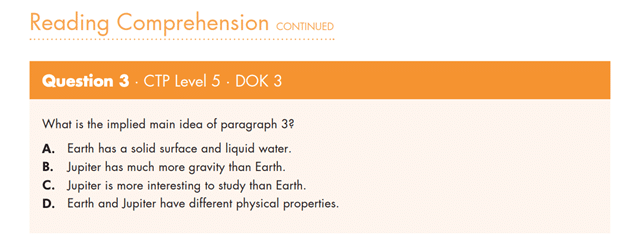
Questions taken directly from CPT 5 Sample material provided by the Educational Records Bureau.
Math:
The Math section of the CPT (Comprehensive Testing Program) offers three types of questions for students.
1. DOK 1 or Depth of Knowledge 1 questions are the easiest of the math questions. They ask you to merely restate facts without any elaborate thought or attention.
Example:
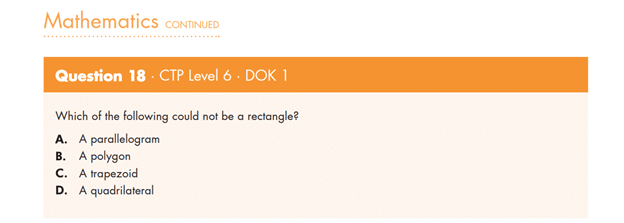
2. DOK 2 or Depth of Knowledge 2 questions are considered rudimentary. They focus on concepts and steps involved in completing a task. Typically students are requested to make an observation, collect data, decipher the reason behind a procedure, and categorize or organize information from graphs and charts. Some questions even require students to carry out an experiment.
Example:
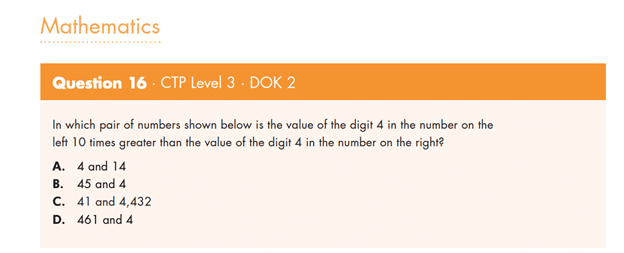
3. DOK 3 or Depth of Knowledge 3 questions are more difficult and require critical thinking skills. The questions asked usually require evidence-based reasoning, deciphering complex data from graphs, using a concept to solve a multi-step problem, and explaining theories with logic. Overall, these questions are more time-consuming and thus require more practice and attention.
Example:
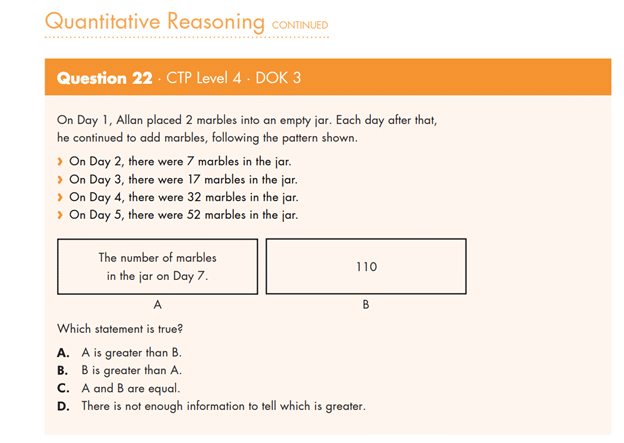
To see these questions with further explanations, check out the ERB’s CTP 5 sample questions or check out TestingMom.com for 100 free CTP questions.
Score Reports:
What does it all mean? I often hear parents panicking trying to decipher the bar graph they’ve been given. It’s overwhelming and confusing, especially when you haven’t been given any information on how it will be used. The scariest part of this testing is the mystery. If schools are upfront and forthcoming about the purpose of their testing, then there is nothing to fear. However, most schools hold their cards close and that can be tough to digest as a parent.
What do we know? Both versions of the CTP5 (paper and online) have their score reports delivered directly to schools. The data is given in percentiles and stanine scores, just like the ISEE. Students are compared to norm groups, their peers, and ranked against other students (in their grade level) in other schools that took the test. Carnegie Prep does a good job breaking it down into simple terms, “For example, students who receive a score of 75th percentile (stanine of 6) on the Verbal Reasoning section have performed better than 75% of the similar population who took the test.” Believe it or not, some schools opt to keep the scores private and not share with parents. Yikes!
While ERB’s website tries to break down the abbreviations used on the score report, it’s still quite confusing if you haven’t seen an ERB score report before. If you’re still feeling lost, try David Posnack Jewish Day School’s helpful Youtube video with visuals. And if you’re gearing up for the ISEE test as well, there are a multitude of ways to prepare yourself for the anxiety that comes with being a parent watching their child go through these tests.
As always, remember the testing process can be stressful for students and parents alike. We’re here for both of you every step of the way.
Photo by Arthur Krijgsman from Pexels




















